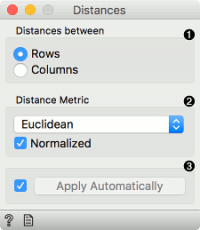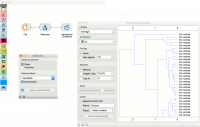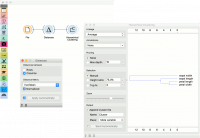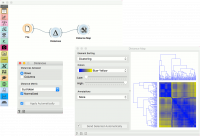Difference between revisions of "Orange: Distances"
Onnowpurbo (talk | contribs) (Created page with "Sumber: https://docs.biolab.si//3/visual-programming/widgets/unsupervised/distances.html Computes distances between rows/columns in a dataset. Inputs Data: input datas...") |
Onnowpurbo (talk | contribs) (→Contoh) |
||
| (6 intermediate revisions by the same user not shown) | |||
| Line 2: | Line 2: | ||
| − | + | Menghitung distance antara baris/kolom di dataset. | |
| − | + | ==Input== | |
| − | + | Data: input dataset | |
| − | + | ==Output== | |
| − | + | Distances: distance matrix | |
| − | + | Widget Distances menghitung jarak antara baris atau kolom dalam dataset. Secara default, data akan dinormalisasi untuk memastikan perlakuan yang sama atas individual feature. Normalisasi selalu dilakukan column-wise (menggunakan kolom sebagai referensi). | |
| − | Sparse data | + | Sparse data hanya bisa digunakan dengan Euclidean, Manhattan dan Cosine metric. |
| − | + | Matrix distance oleh Widget Distances yang dihasilkan dapat diumpankan lebih lanjut ke Widget Hierarchical Clustering untuk mengungkap group dalam data, ke Widget Distance Map atau Widget Distance Matrix untuk memvisualisasikan jarak (Widget Distance Matrix bisa sangat lambat untuk dataset yang besar), ke Widget MDS untuk memetakan contoh data menggunakan matrix distance dan akhirnya, disimpan dengan Widget Save Distance Matrix. Distance File dapat di load dengan Widget Distance File. | |
| − | Distances | + | Widget Distances juga bekerja dengan baik dengan add-on Orange lainnya. Widget Distance Matrix dapat diumpankan ke Widget Network from Distances (Network add-on) untuk mengubah matrix menjadi graph dan ke Widget Duplicate Detection (Text add-on) untuk menemukan duplikasi dokumen dalam corpus. |
| − | + | [[File:Distances-stamped.png|center|200px|thumb]] | |
| − | + | * Choose whether to measure distances between rows or columns. | |
| + | * Choose the Distance Metric: | ||
| + | ** Euclidean (“straight line”, distance between two points) | ||
| + | ** Manhattan (the sum of absolute differences for all attributes) | ||
| + | ** Cosine (the cosine of the angle between two vectors of an inner product space) | ||
| + | ** Jaccard (the size of the intersection divided by the size of the union of the sample sets) | ||
| + | ** Spearman(linear correlation between the rank of the values, remapped as a distance in a [0, 1] interval) | ||
| + | ** Spearman absolute(linear correlation between the rank of the absolute values, remapped as a distance in a [0, 1] interval) | ||
| + | ** Pearson (linear correlation between the values, remapped as a distance in a [0, 1] interval) | ||
| + | ** Pearson absolute (linear correlation between the absolute values, remapped as a distance in a [0, 1] interval) | ||
| + | ** Hamming (the number of features at which the corresponding values are different) | ||
| + | ** Bhattacharyya distance (Similarity between two probability distributions, not a real distance as it doesn’t obey triangle inequality.) | ||
| + | * Normalize the features. Normalization is always done column-wise. Values are zero centered and scaled. In case of missing values, the widget automatically imputes the average value of the row or the column. The widget works for both numeric and categorical data. In case of categorical data, the distance is 0 if the two values are the same (‘green’ and ‘green’) and 1 if they are not (‘green’ and ‘blue’). | ||
| + | * ick Apply Automatically to automatically commit changes to other widgets. Alternatively, press ‘Apply’. | ||
| − | + | ==Contoh== | |
| − | + | Contoh pertama menunjukkan penggunaan widget Distances. Kita menggunakan data iris.tab dari widget File. Kita menghitung jarak antara instance data (baris) dan meneruskan hasilnya ke Hierarchical Clustering. Berikut adalah Workflow sederhana untuk menemukan grup / cluster dalam instance data. | |
| − | + | [[File:Distances-Example1-rows.png|center|200px|thumb]] | |
| − | + | Atau, kita dapat menghitung jarak antar kolom dan menemukan betapa miripnya feature-feature yang ada. | |
| − | |||
| − | |||
| − | |||
| − | |||
| − | |||
| − | |||
| − | |||
| − | |||
| − | |||
| − | |||
| − | |||
| − | |||
| − | |||
| − | |||
| − | |||
| − | |||
| − | |||
| − | |||
| − | |||
| − | |||
| − | |||
| − | |||
| − | |||
| − | |||
| − | |||
| − | |||
| − | |||
| − | |||
| − | |||
| − | |||
| − | |||
| − | |||
| + | [[File:Distances-Example1-columns.png|center|200px|thumb]] | ||
| + | Contoh kedua menunjukkan bagaimana memvisualisasikan matrix distance yang dihasilkan. Cara yang bagus untuk mengamati kesamaan data adalah dalam Distance Map atau dalam MDS. | ||
| + | [[File:Distances-Example2.png|center|200px|thumb]] | ||
==Referensi== | ==Referensi== | ||
Latest revision as of 10:29, 6 March 2020
Sumber: https://docs.biolab.si//3/visual-programming/widgets/unsupervised/distances.html
Menghitung distance antara baris/kolom di dataset.
Input
Data: input dataset
Output
Distances: distance matrix
Widget Distances menghitung jarak antara baris atau kolom dalam dataset. Secara default, data akan dinormalisasi untuk memastikan perlakuan yang sama atas individual feature. Normalisasi selalu dilakukan column-wise (menggunakan kolom sebagai referensi).
Sparse data hanya bisa digunakan dengan Euclidean, Manhattan dan Cosine metric.
Matrix distance oleh Widget Distances yang dihasilkan dapat diumpankan lebih lanjut ke Widget Hierarchical Clustering untuk mengungkap group dalam data, ke Widget Distance Map atau Widget Distance Matrix untuk memvisualisasikan jarak (Widget Distance Matrix bisa sangat lambat untuk dataset yang besar), ke Widget MDS untuk memetakan contoh data menggunakan matrix distance dan akhirnya, disimpan dengan Widget Save Distance Matrix. Distance File dapat di load dengan Widget Distance File.
Widget Distances juga bekerja dengan baik dengan add-on Orange lainnya. Widget Distance Matrix dapat diumpankan ke Widget Network from Distances (Network add-on) untuk mengubah matrix menjadi graph dan ke Widget Duplicate Detection (Text add-on) untuk menemukan duplikasi dokumen dalam corpus.
- Choose whether to measure distances between rows or columns.
- Choose the Distance Metric:
- Euclidean (“straight line”, distance between two points)
- Manhattan (the sum of absolute differences for all attributes)
- Cosine (the cosine of the angle between two vectors of an inner product space)
- Jaccard (the size of the intersection divided by the size of the union of the sample sets)
- Spearman(linear correlation between the rank of the values, remapped as a distance in a [0, 1] interval)
- Spearman absolute(linear correlation between the rank of the absolute values, remapped as a distance in a [0, 1] interval)
- Pearson (linear correlation between the values, remapped as a distance in a [0, 1] interval)
- Pearson absolute (linear correlation between the absolute values, remapped as a distance in a [0, 1] interval)
- Hamming (the number of features at which the corresponding values are different)
- Bhattacharyya distance (Similarity between two probability distributions, not a real distance as it doesn’t obey triangle inequality.)
- Normalize the features. Normalization is always done column-wise. Values are zero centered and scaled. In case of missing values, the widget automatically imputes the average value of the row or the column. The widget works for both numeric and categorical data. In case of categorical data, the distance is 0 if the two values are the same (‘green’ and ‘green’) and 1 if they are not (‘green’ and ‘blue’).
- ick Apply Automatically to automatically commit changes to other widgets. Alternatively, press ‘Apply’.
Contoh
Contoh pertama menunjukkan penggunaan widget Distances. Kita menggunakan data iris.tab dari widget File. Kita menghitung jarak antara instance data (baris) dan meneruskan hasilnya ke Hierarchical Clustering. Berikut adalah Workflow sederhana untuk menemukan grup / cluster dalam instance data.
Atau, kita dapat menghitung jarak antar kolom dan menemukan betapa miripnya feature-feature yang ada.
Contoh kedua menunjukkan bagaimana memvisualisasikan matrix distance yang dihasilkan. Cara yang bagus untuk mengamati kesamaan data adalah dalam Distance Map atau dalam MDS.



